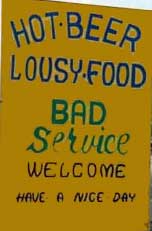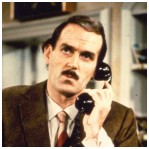There’s richness in private life from which to draw business wisdom. When it comes to customer service, it’s easy for me to recollect a classic scenario my daughter and I experienced when visiting our English family for the first time, in 1998. They hosted a “brilliantly smashing” visit; we crammed a phenomenal amount into everyday. One day, after visiting Oxford, Bourton-on the-Water, Shakespeare’s birthplace and Anne Hathaway’s cottage, in Stratford-Upon-Avon (don’t you just love the names of places in England that are by the water), we were hungrrrry. Too hungry to travel three more hours without dinner. We stopped at a quaint 500 year old roadside inn in the hamlet of Drayton. Gleaning business wisdom from my holiday was the last thing on my mind.
We walked in and immediately felt our “visitors” status, compared to all the “regulars”. Since no one showed us to a table, we found our own, and then waited several minutes for menus. Mike, the owner, appeared saying (in a tone that almost dared us to wait), “We’re terribly busy and the kitchen is behind; expect a 45 minutes if you want food.”
We waited–45 minutes sped along. Then one hour came and went…then one hour and 15 minutes! At this point, if I was in my own country, I would’ve asked, “Where’s the beef?”, but I was a visitor, with family I was just coming to know, so I held my tongue. At one hour and 15 minutes a couple arrived and was promptly greeted and seated. By our 90 minute mark they had their dinners, while we had yet to see our appetizers! I pointed this out to my family (we all saw it pretty much simultaneously), but it was difficult getting Mike’s attention. Maybe I was paranoid, but I swear he was avoiding us! Minutes later, Mike finally materialized (for the first time in an hour). As he breezed past our table, we all boisterously piped up with, “We’ve been waiting an hour and a half for food which we thought would show up at least 30 minutes ago, while those people who’ve just arrived have their dinners already!”. As whiney as we may have sounded, in the moment, we felt quite justified.
Mike didn’t apologize. He became verbally defensive and reiterated, with strained mock patience, “We’re terribly busy in the kitchen, and I told you this from the start and…blah blah blah blah blah”. We were so disgusted we asked for our money back and were prepared to leave hungry (at 10 pm with miles to go before we slept!). He wouldn’t give us our money back! You see, you pay in advance for “bar” food in an English Pub. We raised quite a ruckus. If I hadn’t been so emotionally involved in the moment I’m sure I’d have been embarrassed by our behaviour. Other patrons were definitely disturbed by our outburst, but Mike found it more important to “be right, than happy” and continued to argue his position. In the middle of this, the food arrived! We’d worked ourselves up, demanded our money back, was told “no” by the owner of the establishment and now…now we were suppose to stay and eat? Well there it was and there we were…and it was 10:30 pm. by this point. So we stayed and ate, grumbling and rehashing the entire episode, still at a volume which disturbed the ambiance of this little country inn on an mid-summer’s Saturday night (it was more like a mid-summer’s nightmare than a dream). I don’t think Mike had ever thought of the words or concept of “damage control”.
To the bitter end this man could have fixed things with us…offered a 50 percent discount, free desserts, the whole thing complimentary, whatever. But to the bitter end Mike preferred to dig in, calling his customers wrong and himself right. Mike may have owned a restaurant but he didn’t know how to run one.
What could Mike have done differently, to save the reputation of his inn, in our eyes (and to cause me not to have “ammo” for writing this article)? What can we do differently in our own businesses, to secure and/or save our own organization’s good name (and perhaps our own, along the way), in the eyes of our customers–even when the customer is wrong and we’re right?
Try these suggestions:
- Be solution oriented: Quickly and silently assess the “problem” and then devise ideas to “put out the fire”. Ask yourself/the customer, “What can I do to turn this around and create customer satisfaction?”
- Practice empathic listening and response:
 No one wants to yell at a brick wall–walls don’t have ears. No one wants to deliver angry statements to inanimate objects. Anger wants to be heard and received by another set of human ears…and if those ears are attached to a person with power or decision making authority, all the better! Unless you want absolutely everyone else to hear your customer’s anger, developing empathic skills is one of the most important customer service practices you can demonstrate. When people are spewing their annoyance, they want to be heard. When we decide to respond to the customer’s emotional expressions of dissatisfaction with our excuses and defensive explanations, we’ve taken it too personally. When we argue back, we tell the customer we’re more interested in defending ourselves than making it “right”. Empathize with expressed angry feelings first (while still holding on to your personal dignity); deal with actual content of the anger (the specifics) second. Patience and thoughtfulness, and addressing the dissatisfied person’s feelings first and content second, may save your relationships from “one hundred days of sorrow”!
No one wants to yell at a brick wall–walls don’t have ears. No one wants to deliver angry statements to inanimate objects. Anger wants to be heard and received by another set of human ears…and if those ears are attached to a person with power or decision making authority, all the better! Unless you want absolutely everyone else to hear your customer’s anger, developing empathic skills is one of the most important customer service practices you can demonstrate. When people are spewing their annoyance, they want to be heard. When we decide to respond to the customer’s emotional expressions of dissatisfaction with our excuses and defensive explanations, we’ve taken it too personally. When we argue back, we tell the customer we’re more interested in defending ourselves than making it “right”. Empathize with expressed angry feelings first (while still holding on to your personal dignity); deal with actual content of the anger (the specifics) second. Patience and thoughtfulness, and addressing the dissatisfied person’s feelings first and content second, may save your relationships from “one hundred days of sorrow”! - Information share all along the way: This “trick” will sooth many savage “beasts”. Keep customers in the loop. When you know you’re off track, or behind, give them updates–tell them what you’re doing to resolve their concerns. Make customers emotionally comfortable while they tolerate delays. I once attended a video-conference presentation that went screwy. We waited half an hour without reconnection. The audience was getting impatient, annoyed and restless. The host quickly demonstrated points 1 and 2 by ordering wine for all. The customers were immediately happy! The hook-up was fixed and we watched the end of the presentation (even if we were all a little “happier” than we should’ve been at 3 in the afternoon on a work day!). This organization was a class act. They “ate the crow” they felt they needed, and moved to action to keep their clients emotionally comfortable while dealing with technical difficulties. We all walked away remembering how classy they were, rather than feeling bitter about the delay.
- Learn when and how to say “sorry”: Apologize for errors for which you know you are responsible, and that have caused inconvenience, loss of time or money, for your customer(s). Don’t apologize where you have not erred, eg. apologizing for company policy (instead, an empathic response is more appropriate than an apology). “Sorry” is for mistakes only.
- Say “thank-you”: When we sincerely thank our customers for eg. patience, understanding, feedback, etc., we stand a better chance that they will feel honoured and soothed. We also stand a better chance that they will use our services again, telling positive stories to their circle of influence.
- Use positive words: Focus on what you can do, and what you will do, rather than on what you can’t or won’t. I’m a big champion of the right words, for the right people, at the right time. Review “Working Wisdom” back-issues on this suggestion at ninaspencer.com.
- Keep you cool: The person who is not angry is in control. The customer is “off duty” as far as work is concerned but you’re not! Do whatever it takes to keep your sincere and open “cool”. It doesn’t help to pretend that you’re calm, while you’re visibly gnashing your teeth and methodically pacing your words, creating a strained voice while the tendons stick out in your neck. “Fake it til you make it” won’t cut it in such situations. The angry customer will see right through your artificial graces. You’ve got to mean it.
- Find your sense of purpose: In times of challenge or strain with customers, it helps to lean on a clearly articulated, broadly stated personal purpose for why you do “this job”. Positively identify why you stay and then remind yourself of this when you must.
The bottom line is this: if you don’t have customers, you don’t have a reason to professionally exist in the line of work you’re performing. Customers are king and queen…and organizations that sincerely “get” that, have head and shoulders advantage over their competitors. Unless, of course, you prefer to think of yourself as Basil Fawlty, of the British Sitcom, Fawlty Towers (hysterically well played by John Cleese). Basil is a seaside hotel owner who treats all his guests as major pains, inconveniences, idiots and imbeciles. So what’s it going to be, “Mikey”? This question is posed to that bit of “Mike” which, at least from time-to-time, resides in us all. Yes, indeed, it is amazing what business wisdom can be gleaned from vacation; why bother learning from customer service case studies when you can get so much more from actual life?
P. S. To this day, if you ask my daughter to share her most vivid memory of her first trip to England, she will recount in great detail the pub fiasco of that mid-summer’s nightmare in the English hamlet of Drayton. Keep that in mind the next time you are faced with a disgruntled customer. How do you want your organization to be remembered in such an instant? You’d better care, because customers have long memories and their loyalty (or lack of it) is directly related to how they are treated by you/your organization, in both the good days and the bad.














